 Wisconsin Lawyer
Wisconsin Lawyer
Vol. 83, No. 9, September 2010
 Not that long ago they were the young upstarts in the law profession. They were the newly minted lawyers, admitted to the bar at the turn of the century, who brought with them their own attitudes, priorities, and career ambitions.
Not that long ago they were the young upstarts in the law profession. They were the newly minted lawyers, admitted to the bar at the turn of the century, who brought with them their own attitudes, priorities, and career ambitions.
Where have their career paths taken them since? The After the JD Study of Lawyers’ Careers is an attempt to discover answers.
The three-phase study tracks the careers of a nationally representative cohort of more than 5,000 lawyers admitted to the bar in the year 2000. The first two phases of the project, referred to briefly as AJD1 and AJD2, surveyed these attorneys when they were three and seven years into their careers. The third phase is to be completed by 2012.
The surveys conducted so far resulted in reports published in 2004 and 2009 by the American Bar Foundation and the National Association for Law Placement Foundation for Law Career Research and Education, two of the study’s sponsors.
In the second report, the authors write, “We hope AJD2 will provide a solid basis for future efforts to understand the changing character of legal careers.”
Here we look at some of the AJD2 findings, interwoven with the experiences of several State Bar of Wisconsin members who also were admitted to the bar in 2000. The AJD2 data were collected in 2007 and early 2008. Thus, the Wisconsin attorneys we talked to have had almost three additional years for their professional and personal lives to evolve.
On the Move
In recent years, job mobility has been an oft-discussed issue in the legal profession. The AJD studies show that job mobility begins early in lawyers’ careers.
AJD1 discovered that more than a third of respondents already had changed jobs at least once during the first three years out of law school. What’s more, 44 percent were planning to move to a new job within two years. AJD2 found that:
- Between 2003 and 2007, each respondent had held an average of two different jobs.
- 62 percent had changed jobs at least once between 2003 and 2007.
- Not only did these lawyers change jobs, 52 percent of them had switched into different practice settings.
- Movement out of practice settings was highest in larger law firms, public interest law, and legal services or public defender offices.
The AJD2 authors note that AJD3 will shed light on whether these lawyers’ job-changing tendencies diminished with the economic downturn. The AJD2 data were collected before the full impact of the financial crisis had hit.
Rob Teuber falls right on the AJD2 average with his job history; he held two different jobs between 2003 and 2007. After graduating from Marquette University Law School in 2000, he went to work for a large Milwaukee firm, figuring he’d stay for a long time. But in 2005, he took a job at Weiss Berzowski Brady LLP, a 23-attorney firm in Milwaukee.
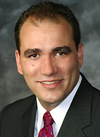
"I [now] have more responsibility for cases, rather than just handling component parts. I also have the freedom to build the practice the way I think it should be built." – Rob Teuber
For Teuber, the motivation behind the shift to a mid-sized firm was to grow professionally. At the large firm, “I was going to be the youngest guy in the tax practice group for a very long time,” he says. “Even after I’d been practicing for 10 years, I was going to be at the bottom end of that group. But here I have more responsibility for cases, rather than just handling component parts. I also have the freedom to build the practice the way I think it should be built.”
New Directions
Three years ago, Catherine Ritterbusch, a Marquette University Law School graduate, switched from private practice (five years in a mid-sized firm, two years in a large firm, both in Milwaukee) to being a professor at Mount Mary College, a private women’s college in Milwaukee. She heads the justice department, teaches several courses, and advises pre-law students, among other tasks. “At a small institution, one wears many hats,” she notes, “and I enjoy that.”
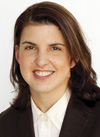
"I was stressed by the hours and the feeling of being engaged in conflict. It took me some time to realize that [private practice litigation] wasn’t a good environment for me." – Catherine Ritterbusch
She had come to not enjoy certain aspects of being a private practice litigator. “I was stressed by the hours and the feeling of being engaged in conflict,” she says. “It took me some time to realize that wasn’t a good environment for me. Twenty hours a week, maybe. But 50 hours a week of being embroiled in conflict situations? I wanted to do something else.”
In her current job, her rewards come from “helping people work toward becoming their best selves and not only achieving their goals, but also figuring out what their goals are,” Ritterbusch says.
Jill Kastner is another former big-firm attorney who’s engineered a major career shift. After finishing UCLA Law School, she worked for six years in two California offices of a 1,000-attorney Chicago-based firm, where she typically billed 2,400 to 2,600 hours a year. In 2006 she and her husband moved back to their native Wisconsin. She went to work at a large Milwaukee firm for two years, after which she spent a year helping to launch her husband’s business.

"When [the legal services] opportunity came up, it spoke to me. Throughout my career I’d always done a lot of pro bono work, and I enjoyed it." – Jill Kastner
When it came time to consider her next step, Kastner wasn’t sure she wanted to return to the big-firm environment, and she wanted more time to be an active mom for her children, ages 5 and 8. Last December, she took a job at Legal Action of Wisconsin. “When that opportunity came up,” she says, “it spoke to me. Throughout my career I’d always done a lot of pro bono work, and I enjoyed it.”
But this job choice wouldn’t have appealed to her right out of law school. “I was one of those people who bought into the myths about public interest lawyers – that they’re bleeding-heart liberals or can’t get a job with a big firm,” Kastner says. “Through years of dealing with legal service corporations, I learned that’s clearly not true. Now I work as hard as I did in the big firm. I just don’t work as many hours.”
Mark Herman left private practice six years ago to work in government lawyer positions. After graduating from the University of Wisconsin Law School, he took a job with a mid-sized Madison firm, but left after four years. “The biggest issue was my wife’s career,” Herman says. “She was traveling two to three weeks out of every month for her job. I thought government practice would give me more time to be the primary caregiver for our kids,” then ages 3 and 8.
In his first government job, he had more time than in private practice, but he felt less challenged, so he changed jobs again. Since January 2010, he’s been assistant legal counsel for the Wisconsin Department of Administration. Herman says it’s a good fit. “I’ve found a government position that gives me the intellectual challenge I had in private practice,” he says.
Where AJD2 Lawyers Work
Among surveyed AJD2 respondents:
- 17 percent work in government, while 6 percent work for public interest organizations or nonprofits – about the same proportions as in AJD1.
- 19 percent work in business, mostly as inside counsel, up from 8 percent in AJD1. This sector experienced the biggest influx from 2003 to 2007.
- 55 percent work in private law firms, down from 70 percent in AJD1.
- In comparing the proportions of private practice attorneys working in firms of different sizes, the largest shares work in firms having from 2 to 20 lawyers and 251-plus lawyers, at 18 percent and 11 percent respectively. But these proportions are down from 25 percent and 18 percent in AJD1.
The AJD2 report states, “Seven years out, the mega firms are no longer as prominent a setting for lawyers.” Still, that’s where Michael Mayer has chosen to remain ever since graduating from the U.W. Law School. Two years ago, he became a partner at Winston & Strawn LLP, which has 900 attorneys in 14 offices around the world. Mayer does commercial litigation work out of the Chicago office.
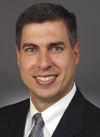
"Sometimes big firms get a bad rap, but the reality is that the resources they provide to younger attorneys are extraordinary." – Michael Mayer
“Sometimes big firms get a bad rap,” Mayer says. “But the reality is that the resources they provide to younger attorneys are extraordinary.”
And it’s more than the salary, Mayer notes. One key factor that’s motivated him to stay these 10 years is the firm’s strong mentoring program. Now he’s a mentor himself. He also appreciates that the firm has a full-time pro bono coordinator, so it’s easy to land pro bono assignments. Mayer tries to do at least 50 hours of pro bono a year, and has sometimes reached annual totals of nearly 200 hours. About 45 percent of AJD2 respondents said they did pro bono, averaging 28 hours a year.
Mayer also refutes the stereotype that young associates in big firms have no life outside of work. “I always found time to socialize,” he says. “The nice thing about working in a big firm is that you have a lot of colleagues at your level. You grow up with them in the firm and become good friends.”
AJD2 found that the proportion of solo practitioners doubled from 2003 to 2007, from 5 percent to 10 percent. Three years later, more lawyers in the cohort probably have made that move.
Brookfield attorney Jonathan Groth launched a solo personal injury practice in March 2010. A Marquette University Law School graduate, he worked first for a small Waukesha general practice firm for three years. His experience there affirmed his preference for personal injury litigation. He then went to work for an eight-attorney Milwaukee personal injury firm for seven years.

"After speaking to attorney friends, I figured there’s never a perfect time to make the move [to open a solo practice]. I just bit the bullet. And, to be honest, I couldn’t be happier." – Jonathan Groth
Having a mortgage and two young sons, ages 2 and 5, “made me think twice about leaving my job to start my own firm,” he says. “After speaking to attorney friends, I figured there’s never a perfect time to make the move. I just bit the bullet. And, to be honest, I couldn’t be happier. I have a fantastic family and a good jump-start on my practice.”
What AJD2 Lawyers Do
Like Groth, Rebecca LoudBear also zeroed in on one area of law early in her career. Right out of the U.W. Law School she worked as a staff attorney for Dane County judges and then for a year as a family law practitioner with a small Beaver Dam firm. LoudBear’s husband, a member of the Menominee Tribe, wanted to move to the reservation. The couple did so, and she began doing legal work for the tribe.
“That’s how I stepped into Indian law,” she explains. “Now it’s my niche. It’s a good fit for me because I get the public interest aspect in my work.” Today she’s deputy attorney general for the Colorado River Indian Tribes in Parker, Ariz.
Groth’s and LoudBear’s experiences are in line with AJD findings that show young lawyers develop “specializations” early in their careers. AJD1 found that three years into their careers, 39 percent of respondents considered themselves to be “specialists,” while 82 percent said they spent at least half their work time in one area of law practice. In AJD2, those proportions rose to 54 percent and 86 percent, respectively.
AJD2 also found that:
- 87 percent of respondents worked full time, down from 94 percent in AJD1.
- 83.5 percent were practicing law in their primary positions, down from 91 percent in AJD1. (This reflects the movement into business settings, mentioned earlier, where lawyers may not be practicing law.)
- 14 percent of women AJD2 attorneys worked part-time, and 2.3 percent of men did so.
Jillayne Verich has worked varied schedules since she got her JD at the U.W. Law School in 2000. She was full-time at Menn Law Firm Ltd. in Appleton for three years and went part-time with the birth of her first child. “They made sure family came first for everyone in the firm, men and women,” Verich says.
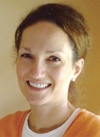
"[My firm] made sure family came first for everyone in the firm, men and women. … They definitely have won my loyalty." – Jillayne Verich
Later she returned to full-time work and after the birth of a second child, switched to permanent part-time. “In 2007, when I was pregnant with my fourth child, I ‘retired,’” Verich says. She now has five children ages 7 and younger.
But Verich says she may return to practice when her children are older. If she does, “Menn Law would be the first place I’d contact,” she says. “If they didn’t have an opening, I’d wait a year or two to go back to them. They definitely have won my loyalty” by accommodating her family’s needs.
As for hours worked, both AJD1 and AJD2 found that the median number of hours lawyers worked in a week was 50. Still, 21 percent of AJD2 lawyers reported working more than 60 hours a week. In mega-firms of 251-plus attorneys, that proportion rose to 41 percent, the highest of any practice setting.
Brook Teuber isn’t in a mega-firm; she’s an assistant district attorney for Jefferson County. But her workweek typically pushes toward 60 hours. “We’ve had such high turnover,” she says. “The crime doesn’t stop, but the funding has. I used to manage to get my work done in an eight-to-five day. That’s impossible now.”

"The crime doesn’t stop, but the funding [for prosecutors] has. I used to manage to get my work done in an eight-to-five day. That’s impossible now." – Brook Teuber
Several colleagues have jumped ship, but Teuber has no such intentions. She’s “fortunate to have a great husband [Rob Teuber] who has a great job,” she says. “If I had to support my family on my income, my perspective would shift.”
Teuber’s own tenacity probably also comes into play. She’s always wanted to be a prosecutor, but when she finished Marquette University Law School in 2000, those jobs were scarce. She volunteered at the Waukesha County district attorney’s office for a few months before she got hired for a temporary position in the Jefferson County district attorney’s office. After some ups and downs with grant funding, she finally landed a full-time job there in 2003.
She’s not inclined to leave now. “I like being a voice for other people, and I like public service,” Teuber says. “There are days I go home, throw up my hands, and say, ‘I need a new career.’ But those are usually small windows of time. I’m very satisfied with my career.”
Career Satisfaction
Many AJD2 respondents would echo Teuber’s sentiments, the survey found. The AJD2 report states, “[C]ontrary to media accounts, AJD respondents in both waves of the study reported generally high levels of satisfaction.” In AJD2, 76 percent of respondents said they were moderately to extremely satisfied with their decision to become a lawyer.
The studies asked respondents to rate their level of satisfaction for 19 different aspects of their jobs. Ratings were on a scale of 1 (highly dissatisfied) to 7 (highly satisfied). The AJD2 level for “opportunity to advance” was slightly lower than in AJD1 (4.65 vs. 4.68). In all other areas, AJD2 levels of satisfaction were higher than in AJD1.
The five aspects that ranked highest for job satisfaction in AJD2 were level of responsibility (5.88), control over how you work (5.83), relationships with colleagues (5.73), substantive area of work (5.59), and intellectual challenge (5.53).
AJD2 also analyzed satisfaction with different job aspects among lawyers in different types of practice settings. Summing up this analysis, the report states: “Lawyers in all settings find some aspects of their work lives that provide them with enough satisfaction to counterbalance the negative aspects of their jobs.”
Not only does every job have its pluses and minuses, but “job satisfaction also comes in different ways at different stages of your career,” says Chris Anderson, who earned his JD from William Mitchell College of Law in 2000 and has been with Heywood, Cari & Anderson S.C., a five-attorney firm in Hudson, since 2001.
“When you do something you’ve never done before, and you do it well, you feel more satisfied,” Anderson explains. “After that it can get a bit redundant. The first time may be more satisfying than the 20th.”
Anderson’s primary practice areas include real estate, criminal defense, personal injury, and civil litigation. He gets the most job satisfaction from “helping people through what are often difficult times for them,” he says, and from constantly learning. For instance, in a case with engineering aspects, he learns a bit about engineering. In a personal injury case, he learns a little about medicine. “There’s so much to learn,” he says, “and not only about the law.”
Dave Adams can relate to that. These days, for instance, he’s learning about renewable energy – not something he figured he’d be dealing with as in-house counsel in the health-care industry. He knew he wanted to work in that industry from the time he was a 19-year-old psychiatric nursing assistant. When he realized he “didn’t like blood,” he decided to pursue an MBA in health-care administration and finance, rather than medical training.
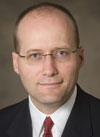
"My in-house counsel job is challenging and fulfilling. If I were in private practice, I might be a partner now. But I wouldn’t be in the industry I’ve always enjoyed." – Dave Adams
Adams got his JD with a certificate in health law from DePaul University College of Law in 2000. Various job steps followed, usually tied to his wife’s moves as a medical resident. In 2007, he became associate general counsel for the Gundersen Lutheran Health System in La Crosse, where he’s learning about, among many other things, renewable energy. His in-house counsel job is “challenging and fulfilling,” he says. “If I were in private practice, I might be a partner now. But I wouldn’t be in the industry I’ve always enjoyed.”
Also rating her career satisfaction high is Tammy Edwards, who’s been an assistant state public defender in Appleton ever since getting her JD at William Mitchell. Unlike many in the AJD2 study group, she’s not inclined to move to another job – even though paltry salary increases have spurred many former public defender colleagues to do so.
“I do think about leaving sometimes,” she says. “But I like what I do.” Besides working with clients, she serves on the county’s Juvenile Executive Committee and the Disproportionate Minority Contact Committee. Such committees “are where things get changed,” Edwards says. “I wouldn’t have those opportunities if I were in private practice.”
Law School Debts Linger
At seven years out of law school, two-thirds of AJD2 respondents still carried education debt, with a median remaining debt of $50,000.
AJD2 looked at how education debt influenced career choices. Asked to rate the importance of being able to pay off education debts when making job choices, respondents gave this factor an average rating of 4.4 on a 7-point scale (7 being “extremely important”), only a little above the midpoint.
But when asked to rate the influence of education debt on their professional and personal lives, 42 percent said education debt had a fairly strong influence on their job choices.
In explaining this apparent contradiction, the AJD2 report surmises: “This tension suggests that while the immediate decision of which job to take is not strongly influenced by debt, respondents nevertheless appear to feel the weight of their debt in a more global way.”
The AJD2 authors also noted as “curious” the finding that public interest attorneys did not view loan repayment assistance programs as particularly useful in repaying their student loans. But this data was collected in the same year Congress passed the College Cost Reduction and Access Act, some provisions of which did not take effect until 2009.
At any rate, hovering law school debts, as well as undergraduate debts, are a fact of life for many lawyers for a long time. Like many colleagues, Adams figures he’ll have his education debts paid off when he hits age 65. The same goes for his wife’s medical school debts.
But Adams takes a philosophic view of the situation. “Each of our debts cost more than our house,” he says. “But its okay because I get to do the work I like doing, which is great. And they can’t repossess my brain.”
Wisconsin Lawyer
